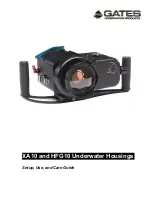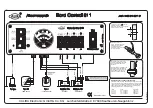
5
0.0 Forward: The Elektra
®
UV Unit is designed for use in swimming pools, fountains, water features, waterfalls
and fish ponds. It is not designed for use in potable (drinking) water installations. Use of this product in
applications other than those indicated above will void your warranty and could be harmful to your health or
the health of others.
1.0 Introduction - How The Elektra
®
UV Unit Works:
Within the Electra
®
UV Unit (which we will refer to throughout
this manual as EUV), a high intensity electrically operated Ultraviolet (UV) bulb is located inside the unit’s wet chamber.
This UV bulb gives off Ultraviolet light wave emissions when lit. The bulb’s operating emission range is within the
Ultraviolet light wave spectrum at 5.7 nm of wavelength. This wavelength is such that when bacteria, protozoa,
viruses, algae spores, or other single celled waterborne microorganisms in the incoming water flow are exposed to
the light waves of the UV bulb for a proper period of time, the DNA of the microorganism is altered or disrupted and
this controls and eradicates these unwanted contaminates and renders them harmless. Your EUV unit has been sized
to produce these important UV rays in the same intensity as is required for Class A potable drinking water, which is
0 microwatts/sec/cm
.
While you may see lesser competitive units of similar vessel size claiming to work on larger ponds or pools, you will
find that these units do not operate at the same high intensity as does the EUV unit and are unable to obtain the
same level of killing power as the EUV unit. Rely on the flow chart shown herein for proper maximum killing power
unit selection for your application.
Pond or pool water containing these unwanted contaminates enters the EUV unit’s wet chamber and is exposed to
the light rays generated by the UV bulb. The EUV unit has been designed to allow for some turbidity in the water, as
turbidity will reduce the UV light wave transmission capability. Therefore, all EUV units are sized to allow for possible
turbidity in the water and the reduction in the killing power of the UV bulb when it nears the end of its useful life.
When the incoming water is exposed to the bulb for the proper duration and intensity, the water exiting the unit is near
drinking water biological quality.
CAUTION!: THIS UNIT IS FOR POND OR POOL USE ONLY. DO NOT USE THIS
UNIT FOR POTABLE (DRINKING) WATER SANITIZATION.
2.0 Pre-Installation -
In order to ensure that your EUV unit functions with the proper exposure time to achieve the
desired water sanitization, it is important to provide the proper water flow rate through the EUV unit. If water passes
through the unit too quickly, the exposure time of the microorganisms to the UV bulb produced rays will not be sufficient
to obtain the desired kill rate. The water flow rate through the UV unit is governed by the piping of your pool or pond
and the size and output of your circulation pump. There also needs to be consideration to the application for the UV
unit. Fish ponds have different requirements than do swimming pools, water features, fountains, or waterfalls.
2.1 Pond Turnover Rates -
Most fish pond experts agree that there is no set formula for the sizing of circulation
pumps and UV systems for ponds. The size of the pond, the depth, plant coverage, the amount of sun exposure
or shade, and the number of fish in the pond all contribute to determining what the flow rate for a pond should
be. The best advise is to consult with a pond expert to determine what the flow rate for your pond should be.
This is the best method of ensuring that your pond is being circulated properly. But absent of that, a general
rule of thumb that can be used for ponds is that the water volume of the pond should be passed through the
filter system every two hours or so. Thus, if you take the volume of your pond (in gallons), and divide that by
120 (the number of minutes in two hours) you will have an approximate desired flow rate for your pond. Then,
you select a pump and filter system that works properly at that flow rate. As an example, a 6000 gallon pond
would have a desired flow rate of 50 gallons per minute (GPM) calculated at 6000 /120 = 50.
2.2
Pool Turnover Rates
- Swimming pools are somewhat simpler to calculate for flow rates. Most residential
pools are designed to have the capacity of the pool turned over every hours. Semi-commercial pools are
normally designed for an 8 hour turnover flow rate. Check with your local jurisdiction for the required flow rate for
your type of pool to be sure. Thus, as an example, using the same formula as above, a 20,000 gallon residential
pool will need to have a pump capable of a 28 GPM flow rate and a 25,000 gallon Semi-commercial pool will
need to have a pump capable of 5 GPM.
Like pools and ponds, the EUV unit needs to be properly sized by flow rate. Moving the water through the EUV
unit’s wet chamber too fast will not allow enough exposure time of the water to be exposed to the UV bulb rays
for the required exposure time. The following chart shows the desired and maximum flow rates for your EUV
unit. Make sure the flow rate of your circulation system pump does not exceed the maximum allowable flow rate
of the UV unit you have selected. (Consult your supplier or pump manufacturer for the pump’s GPM rating if you
Содержание ELEKTRA UV E Series
Страница 19: ...19 NOTES...





































